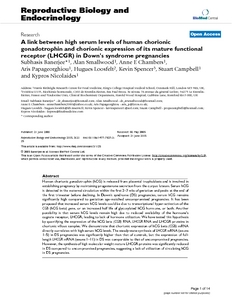Banerjee, S; Smallwood, A; Chambers, AE; Papageorghiou, A; Loosfelt, H; Spencer, K; Campbell, S; Nicolaides, K
(2005)
A link between high serum levels of human chorionic gonadotrophin and chorionic expression of its mature functional receptor (LHCGR) in Down's syndrome pregnancies.
Reproductive Biology and Endocrinology, 3 (25).
ISSN 1477-7827
https://doi.org/10.1186/1477-7827-3-25
SGUL Authors: Papageorghiou, Aris
![[img]](https://openaccess.sgul.ac.uk/100748/1.hassmallThumbnailVersion/1477-7827-3-25.pdf)  Preview |
|
["document_typename_application/pdf; charset=binary" not defined]
Published Version
Download (903kB)
| Preview
|
Abstract
Human chorionic gonadotrophin (hCG) is released from placental trophoblasts and is involved in establishing pregnancy by maintaining progesterone secretion from the corpus luteum. Serum hCG is detected in the maternal circulation within the first 2-3 wks of gestation and peaks at the end of the first trimester before declining. In Down's syndrome (DS) pregnancies, serum hCG remains significantly high compared to gestation age-matched uncompromised pregnancies. It has been proposed that increased serum hCG levels could be due to transcriptional hyper-activation of the CGB (hCG beta) gene, or an increased half life of glycosylated hCG hormone, or both. Another possibility is that serum hCG levels remain high due to reduced availability of the hormone's cognate receptor, LHCGR, leading to lack of hormone utilization. We have tested this hypothesis by quantifying the expression of the hCG beta (CGB) RNA, LHCGR RNA and LHCGR proteins in chorionic villous samples. We demonstrate that chorionic expression of hCG beta (CGB) mRNA directly correlates with high serum hCG levels. The steady-state synthesis of LHCGR mRNA (exons 1-5) in DS pregnancies was significantly higher than that of controls, but the expression of full-length LHCGR mRNA (exons 1-11) in DS was comparable to that of uncompromised pregnancies. However, the synthesis of high molecular weight mature LHCGR proteins was significantly reduced in DS compared to uncompromised pregnancies, suggesting a lack of utilization of circulating hCG in DS pregnancies.
| Item Type: |
Article
|
| Additional Information: |
© 2005 Banerjee et al; licensee BioMed Central Ltd. This is an Open Access article distributed under the terms of the Creative Commons Attribution License (http://creativecommons.org/licenses/by/2.0), which permits unrestricted use, distribution, and reproduction in any medium, provided the original work is properly cited. |
| Keywords: |
Animals, Antibodies, Monoclonal, Antibody Specificity, Blotting, Western, Chorionic Gonadotropin, beta Subunit, Human, Chorionic Villi, Down Syndrome, Female, Glycoprotein Hormones, alpha Subunit, Humans, Mice, Pregnancy, Protein Isoforms, RNA, Messenger, Receptors, LH, Trisomy |
| SGUL Research Institute / Research Centre: |
Academic Structure > Institute of Medical & Biomedical Education (IMBE)
Academic Structure > Institute of Medical & Biomedical Education (IMBE) > Centre for Clinical Education (INMECE ) |
| Journal or Publication Title: |
Reproductive Biology and Endocrinology |
| ISSN: |
1477-7827 |
| Dates: |
| Date | Event |
|---|
| 21 June 2005 | Published |
|
| PubMed ID: |
15969756 |
| Web of Science ID: |
15969756 |
  |
Download EPMC Full text (PDF)
|
 |
Download EPMC Full text (HTML)
|
 |
Go to PubMed abstract |
| URI: |
https://openaccess.sgul.ac.uk/id/eprint/100748 |
| Publisher's version: |
https://doi.org/10.1186/1477-7827-3-25 |
Statistics
Item downloaded times since 14 Feb 2013.
Actions (login required)
 |
Edit Item |




